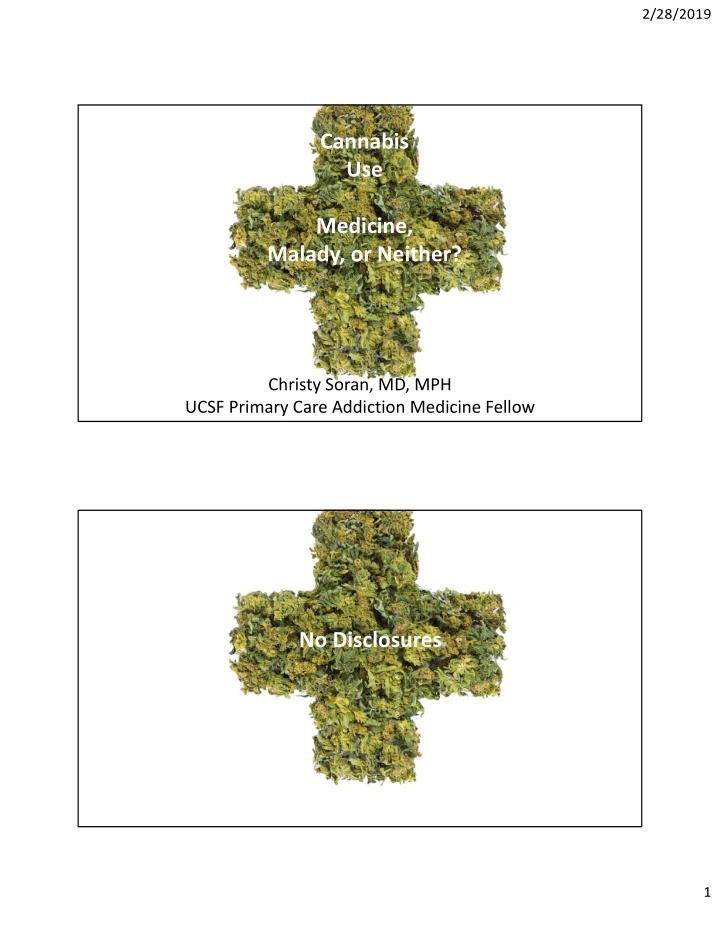



2/28/2019 Cannabis Use Medicine, Malady, or Neither? Christy Soran, MD, MPH UCSF Primary Care Addiction Medicine Fellow No Disclosures 1
2/28/2019 Harvest https://recreationaldispensariesnearme.com/the-10-best-marijuana-dispensaries-in-san-francisco/ Harvest https://recreationaldispensariesnearme.com/the-10-best-marijuana-dispensaries-in-san-francisco/ 2
2/28/2019 Plant Derived (THC and CBD) Synthetic (THC) Photo : https://www.cnn.com/2015/04/16/opinions/medical-marijuana-revolution-sanjay-gupta/index.html Photo: http://www.milwaukeeindependent.com/articles/public-health-alert-issued-result-synthetic-marijuana-hospitalizations/ Source: https://www.mayoclinicproceedings.org/article/S0025-6196(18)30352-5/fulltext CBD THC Agonist CB1 Modulates activity CB1 and CB2 receptors CNS Activity Modulates THC action High Graph Source: https://www.leafly.com/news/cannabis-101/understanding-marijuana-thc-cbd-levels 3
2/28/2019 Colorado Department of Public Health: https://www.colorado.gov/pacific/sites/default/files/MJ_RMEP_Factsheet-Methods-of-Use.pdf Tinctures Colorado Department of Public Health: https://www.colorado.gov/pacific/sites/default/files/MJ_RMEP_Factsheet-Methods-of-Use.pdf 4
2/28/2019 Science is behind commercial Industry Graph: Volkow, N. Adverse Health Effects of Marijuana Use . NEJM, 2014. Photo Source: https://apnews.com/2cb04323f9074c1ca28001693f6e2a8a Schizophrenia or psychosis Mania in bipolar disorder Depression, SI, suicidal completion Social Anxiety Disorder Impaired Performance: Memory, Learning, Attention Cough, phlegm Source: National Academies of Sciences, Engineering, and Medicine, 2017 5
2/28/2019 lung, head, and neck cancers Schizophrenia or psychosis Mania in bipolar disorder Depression, SI, suicidal completion Social Anxiety Disorder Impaired Performance: Memory, Learning, Attention Low birth weight Cough, phlegm Motor Vehicle Accidents Overuse injuries Source: National Academies of Sciences, Engineering, and Medicine, 2017 6
2/28/2019 Evidence for Cannabis as Medicine Conclusive or Substantial Evidence • Chronic pain in adults (cannabis) • Chemotherapy induced nausea or vomiting (oral cannabinoids) • Patient reported MS spasticity (oral cannabinoids) Moderate Evidence • Short‐term sleep (oral cannabinoids) Source: National Academies of Sciences, Engineering, and Medicine, 2017 But what about…. Limited evidence Limited evidence of ineffectiveness • Cachexia related to HIV/AIDS • Dementia • Clinician‐measure MS spasticity • Glaucoma • Tourette syndrome • Depressive symptoms • Anxiety • PTSD • Post‐TBI outcomes https:// marijuanapatients.org/top-10-benefits / 7
2/28/2019 Medical Marijuana Cards in California • AIDS • Anorexia • Cachexia • Cancer • Chronic Pain • Glaucoma • Migraine • Severe Nausea • MS spasms • Disabling Symptoms Source: https://www.cdph.ca.gov/Programs/DO/letstalkcannabis/CDPH%20Document%20Library/October%202017%20Update/CDPH-Medicinal.pdf Photo: https://www.laweekly.com/news/california-officials-move-to-phase-out-medical-marijuana-id-cards-8189346 FDA Approved Medications Name Approved Indication Dronabinol (Marinol, Syndros) Anorexia in patients with AIDS Chemotherapy induced nausea and vomiting Nabilone (Cesamet) Chemotherapy induced nausea and vomiting Cannabidiol (Epidiolex) Lennox‐Gaustat Dravet Syndrome Sativex (Nabiximols) Spasticity or neuropathic pain related to (not FDA approved, approved in Canada MS and UK) 8
2/28/2019 DSM‐5 Criteria for Cannabis Use Disorder 1. More use than intended 2. Inability to cut down 3. Great amounts of time spent dedicated to substance 4. Cravings 5. Continued use despite physical or psychological problems caused 6. Role failure 7. Social or interpersonal problems 8. Recurrent use in situations where it is physically hazardous 9. Giving up activities 10.Tolerance 11.Withdrawal 9
2/28/2019 DSM‐5 Criteria for Cannabis Use Disorder 1. More use than intended 2. Inability to cut down 3. Great amounts of time spent dedicated to substance 4. Cravings 5. Continued use despite physical or psychological problems caused 6. Role failure 7. Social or interpersonal problems 8. Recurrent use in situations where it is physically hazardous 9. Giving up activities 10.Tolerance 11.Withdrawal Prevalence of Cannabis Use Disorder 22 million people used marijuana in the last month (8.5% of US population >12 years) ~4 million people use disorder 10
2/28/2019 Risk factors for cannabis use disorder • Mood disorders • Younger age • Male sex • Anxiety disorders • Native American or Black • Personality disorders • Urban dwelling • Conduct disorder • Divorced or widowed • ADHD • Lower education • Other substance use disorders • Lower income Source: https://www.hiv.uw.edu/go/basic‐primary‐care/substance‐use‐disorders/core‐concept/all https://www‐ncbi‐nlm‐nih‐gov.ucsf.idm.oclc.org/pmc/articles/PMC3069146/ Center for Behavioral Health Statistics and Quality, 2016 National Survey on Drug Use and Health: Detailed Tables, Substance Abuse and Mental Health Services Administration, Rockville 2017 Lower‐risk cannabis use guidelines 1. Most effective: not using 6. Avoid deep or risky inhalation practices 2. Avoid starting young 7. Avoid high‐frequency use 3. Choose low‐potency THC or balanced THC:CBD products 8. Refrain from cannabis‐impaired driving 4. Don’t use synthetic cannabinoids 9. Populations at risk for cannabis‐ 5. Avoid combusted inhalation related health problems should avoid use 10. Avoid combining risk behaviors Resource: Fischer, et al. AJPH 2017. https://ajph.aphapublications.org/doi/full/10.2105/AJPH.2017.303818 11
2/28/2019 Monday ‐ Thursday Friday ‐ Sunday Once a month Key Points Medicine? – Yes • There are a few evidence based conditions and FDA approved indications • There may be more indications in the future Malady? – Yes • Cannabis use disorder can be diagnosed with the DSM‐V Neither? – Yes • Cannabis use is common and not always harmful • There are ways to reduce risks of recreational cannabis use 12
2/28/2019 Thank You 13
Recommend
More recommend